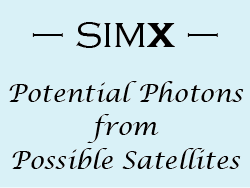simx simulates a photon-counting detector's response to an input source, including a simplified model of any telescope. The code is not a full ray-trace, but a convolution tool that uses standard descriptions of telescope PSF (via either a simple Gaussian parameter, an energy-dependent encircled-energy function, or an image of the PSF) and the detector response (using the OGIP response function) to model how sources will appear.
simx is NOT a full ray-trace code, but rather uses a predefined set of PSFs, vignetting information, and instrumental responses and outputs to make the simulation. It is designed to be a 'approximation' tool to estimate issues such as source confusion, background effects, pileup, and other similar issues.
A simx manual, developed as part of the Hitomi project, has been written by Hiroya Yamaguchi and Kosuke Sato. This manual contains the details of simx's operation and methods, along with a number of fully-worked examples. Note that the manual does not yet contain details of how to use SIMPUT files.
Briefly, to use simx in the simplest mode when a SIMPUT file is not avialble, the user inputs the following information:
| Source | position (RA, Dec) flux (erg/cm2/s) type (point, flat field-covering, or FITS image) |
| Satellite | telescope/detector/filter pointing position (RA, Dec) observing time (seconds) |
Note that both the source position, and the satellite pointing direction, must be specified. If these are the same, then the source is on-axis. Also, if a FITS image is used as the source, the pointing position must agree with the values in the FITS image; otherwise, no image will be detected.
simx itself includes descriptions of a growing number of missions, including X-ray Surveyor, Athena, Hitomi (nee' Astro-H), Gen-X, NuSTAR, and microX. This information is stored in the "inputs/" subdirectory and includes data such as the focal length, pixel size and number, and the relevant background, PSF, and detector responses.
A good source of examples of how to run simx can be found in the test directory; the Makefile shows a large number of different types of simx runs.
The output from simx is an OGIP-standard event file, which can be read by the ds9 image tool or used with the XSELECT or CIAO dmextract tools to create PHA spectrum files.
For bright sources, simx also estimates the number of counts which will have reduced resolution due to a 'deadtime'-like effects. This includes calculations of the relative numbers of 'High Res', 'Mid Res', and 'Low Res' events for the calorimeter. As noted above, this problem is harder for silicon devices such as CCDs and APSs, and so no pileup fraction is calculated for such devices.
The code has been tested on Linux and OS X.
As of version 2, simx can use SIMPUT files, and by default generates SIMPUT files as output if the input source is not a SIMPUT file. There are some test cases in the test/ directory, but little in the way documentation. Please contact the helpdesk for assistance.
Please use the links at left for more information on installing and running simx.
